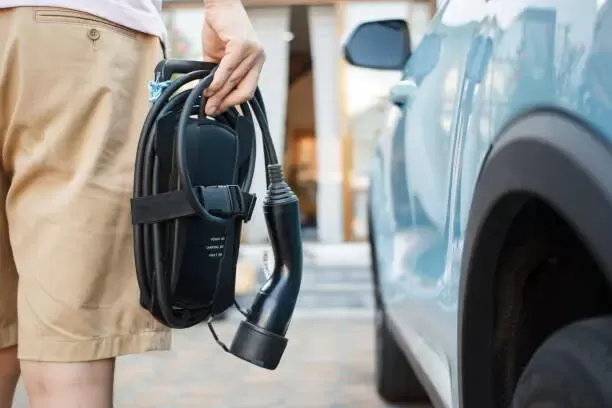Notifications

7 minutes, 30 seconds
-13 Views 0 Comments 0 Likes 0 Reviews

Electric vehicles (EVs) are rapidly reshaping how we travel—but one question many new owners face is: How do I keep my car charged when I’m away from home or far from public stations? The answer increasingly lies in portable EV chargers.
These compact, easy-to-carry devices let you recharge your EV anywhere there’s a compatible power outlet—whether at home, on a road trip, work, or even a remote cabin. As EV adoption grows worldwide and drivers leave traditional gas vehicles behind, portable chargers are becoming an essential tool for worry-free electric driving.
In this comprehensive guide, we’ll explore how portable chargers work, their benefits, how to pick the right one, and why they’re here to stay in the evolving EV ecosystem.
A portable EV charger is a compact, lightweight charging unit designed for mobility and convenience. Unlike permanently installed home or public chargers, portable chargers plug into existing electrical outlets and connect directly to your vehicle’s charging port.
Typical components include:
Control Box: Regulates and monitors power flow safely from outlet to vehicle.
Power Cable: Connects to a standard electrical outlet—either 120V (Level 1) or 240V (Level 2).
Connector Plug: Plugs into your EV’s charging port (usually SAE J1772 for most non-Tesla vehicles; Tesla users require an adapter).
They’re designed to be stored easily in your trunk or garage—ready to provide a charge anytime, anywhere.
Portable chargers operate much like home chargers:
Plug Into Power: Connect to a compatible outlet (120V for Level 1, 240V for Level 2).
Power Regulation: The control box ensures steady, safe electricity flow at the right voltage and amperage.
Vehicle Connection: The connector locks into your EV port, forming a secure, weatherproof link.
Charging & Monitoring: Indicator lights, displays, or smartphone apps show charging status and battery levels in real time.
Main benefit: Freedom from relying solely on fixed charging points.
True Flexibility: Charge your EV wherever a compatible outlet is available. Perfect for trips, camping, or visiting friends without chargers.
No Reliance on Public Infrastructure: Essential for rural travel, older buildings, or locations lacking public chargers.
Cost-Effective: Typically less expensive than installing a dedicated Level 2 home charger; can be shared among vehicles or loaned.
Plug-and-Play: No permanent wiring or installation required—just plug in and go.
Compact & Lightweight: Easy to store and transport, with many models offering protective cases.
Emergency Backup: Keep a portable charger handy for unexpected low-battery situations away from fast chargers.
| Level | Power Source | Charging Speed | Typical Use |
|---|---|---|---|
| 1 | Standard 120V household plug | Adds 3–5 miles range per hour | Overnight home charging, backup |
| 2 | 240V outlet (dryer, RV plug) | Adds 12–30 miles range per hour | Faster home or travel charging |
| 3 | High-voltage DC fast chargers | 80% charge in 20–60 minutes | Long-distance road trips, highway |
Portable chargers currently support Level 1 and Level 2 only. Level 3 DC fast chargers require specialized, high-voltage infrastructure unsuitable for portable devices.
Know Your Outlets: Identify 120V vs. 240V availability at your home, workplace, or travel stops.
Check Vehicle Limits: Confirm your EV’s max charging amperage to match your charger.
Adjust Amperage Wisely: Select appropriate amperage on adjustable chargers to prevent tripping breakers.
Use Heavy-Duty Extension Cords: If needed, choose outdoor-rated, heavy-duty cords for safety.
Monitor Charging: Use built-in displays or apps to track progress.
Store Properly: Keep your charger clean, dry, and protected to extend lifespan.
Amperage & Output: Higher amps = faster charging; make sure your EV and electrical system can handle it.
Cable Length: Longer cables offer flexibility but add weight and bulk.
Plug Compatibility: Ensure your charger’s plug matches available outlets; some include adapters.
Portability: Look for lightweight, compact designs with carrying cases if you travel often.
Weather Resistance: Opt for outdoor-rated chargers if charging outside.
Safety Certifications: Choose chargers with local approvals and built-in safety features like overcurrent and overheat protection.
Portable chargers don’t replace fixed home or public chargers but fill important gaps:
Apartment/Condo Residents: Ideal when permanent chargers can’t be installed.
Business Fleets: Convenient to top off vehicles between routes.
Disaster Preparedness: Works with backup generators during outages.
Travelers & Campers: Charge at cabins, RV parks, or campgrounds where Level 2 outlets are available.
With ongoing advancements, expect portable chargers to become faster, smarter, and more user-friendly. Features like app-controlled scheduling, automatic amperage adjustment, and real-time energy tracking are emerging.
As charging networks expand but remain incomplete in some regions, portable chargers will remain a vital tool for flexible, accessible EV charging.
A portable EV charger isn’t just an accessory—it’s a practical, empowering tool that puts charging flexibility in your hands. Whether you’re commuting in the city, embarking on a road trip, or camping off-grid, portable charging provides peace of mind and convenience.
As electric driving continues to grow, portable chargers are set to play an increasingly important role in keeping EV drivers powered up—wherever the road takes them.Know more about Google SEO Directory
China EV Chargers EV Charger Manufacturer EV Charging Solutions

